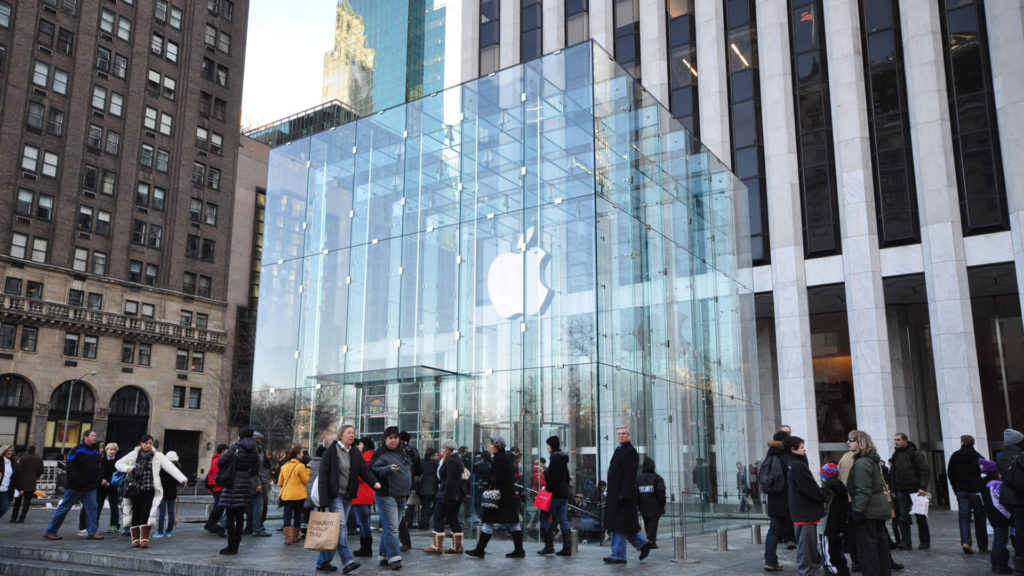This week, Samsung announced its 4th quarter operating profit will decline 29% – a surprise figure that comes far below analysts’ estimates – “amid mounting macro uncertainties.” The firm cites lack of demand for microchips and intensifying competition in the handset space as drivers for the lower forecast.
Despite the firm’s record profits over the last 18 months, consumer demand both for handsets and for macro chips is leveling off and appears to be at a tipping point.
This of course follows Apple’s recent nose dive in valuation after announcing a significant cut to their own revenue forecast. Similarly citing lack of demand, for Apple, troubles are running deep. After losing its place as the world’s most valuable company to Amazon and sliding further down to 4th behind Microsoft and Google, CEO Tim Cook let slip a worrying tip to investors about waning consumer demand for new iPhones.
Apple and Samsung stock prices (Jan 2016-Jan 2019)

“While macroeconomic challenges in some markets were a key contributor to this trend, we believe there are other factors broadly impacting our iPhone performance,” Cook wrote in a letter to shareholders, “including consumers adapting to a world with fewer carrier subsidies, US dollar strength-related price increases, and some customers taking advantage of significantly reduced pricing for iPhone battery replacements.”
The statement about battery replacements, coupled with reports of weeks-long waiting lists for the discounted parts, made clear that demand for new iPhone batteries was high, and implied that demand for new iPhones was lukewarm. According to Yahoo Finance, “What should disappoint investors most after Apple’s news is that the battery promotion seems to show a clear change in the behavior of consumers buying iPhones… Recent editions of iPhone are great devices, but no longer enough on their own to motivate consumers that are seeing sticker prices well north of $700 per phone as carrier subsidies have gone by the wayside.”
Data predicts worrying trends
Leveraging Outside Insight to dig into Apple’s performance online, we see that traffic to Apple.com has reached a plateau in 2018.

In response, the brand has significantly dialed up spend in online marketing in an effort to maintain peaks in growth it previously enjoyed.

External factors impacting the industry
In addition to any internal factors impacting growth among major global consumer electronics companies, the convergence of a number of external factors is doing little to quell investors’ concerns. Here’s a look at major recent events that might be to blame for less than promising forecasts:
- Decreasing price point for memory chips
-
-
- Proliferation of internet-connected devices and data servers drove up prices for memory chips – core to Samsung’s business – over the last 2 years, but now demand is leveling off and prices are expected to decline
- “The memory chip’s down cycle is expected to be at a much deeper depth than expected,” said Lee Seung-woo, an analyst at Eugene Investment & Securities, for the Wall Street Journal
- Other chip producers like Micron and Western Digital face similar threats
-
- Decline in global smartphone demand + changing consumer behavior
-
-
- For the three months ended Sept. 30, global smartphone shipments fell 7% from a year earlier, the fourth straight quarter of declines, according to market researcher Canalys
- Samsung reported weak demand last year for its two flagship devices, the Galaxy S9 and the Galaxy Note 9, as consumers viewed the devices as incremental upgrades over prior models
- Fewer owners are racing to upgrade their phones across the board
-
- Shortfall in production of processing chips
- Global trade turmoil
-
-
- US-China trade tensions are increasing costs to produce and import/export goods
- This has caused a slowdown in investment in cloud computing and artificial intelligence
- China’s VC funding in US startups has slowed to a halt
-
- China’s struggling economy
-
-
- The Chinese economy may be entering recession, resulting in significantly lower demand for iPhones in China, which accounts for 20% of Apple sales
- China’s manufacturing industry contracted, reaching the lowest level since February 2016
- Many Chinese buyers choose to purchase from local brands amid rising competition
-
- Rising anxiety about the global economy and financial markets
-
- Discontent over the US Federal Reserve’s monetary policy
- Rising volatility and a slump in US tech shares to start off 2019
- Economists at Goldman Sachs lowered their U.S. growth forecast for the first half of this year to a 2% annual rate from 2.4%
- US manufacturing growth slowed sharply in December, adding to concerns about cooling economic expansions in the U.S. and abroad and slowing momentum
- Declines in oil prices that have idled production in the energy sector
Apple and Samsung are not alone, and will continue to face external pressures like the cost of production, pressure to innovate with new technologies like 5G and foldable devices and increasing competition at more affordable rates. Any factor may prove to be a tipping point as we enter what appears to be an incresingly tumultuous economy 2019.

